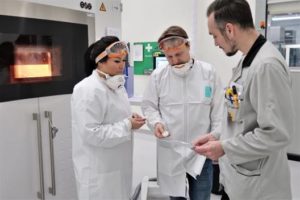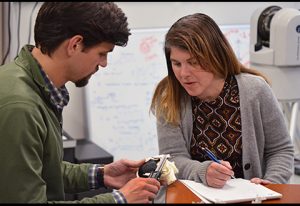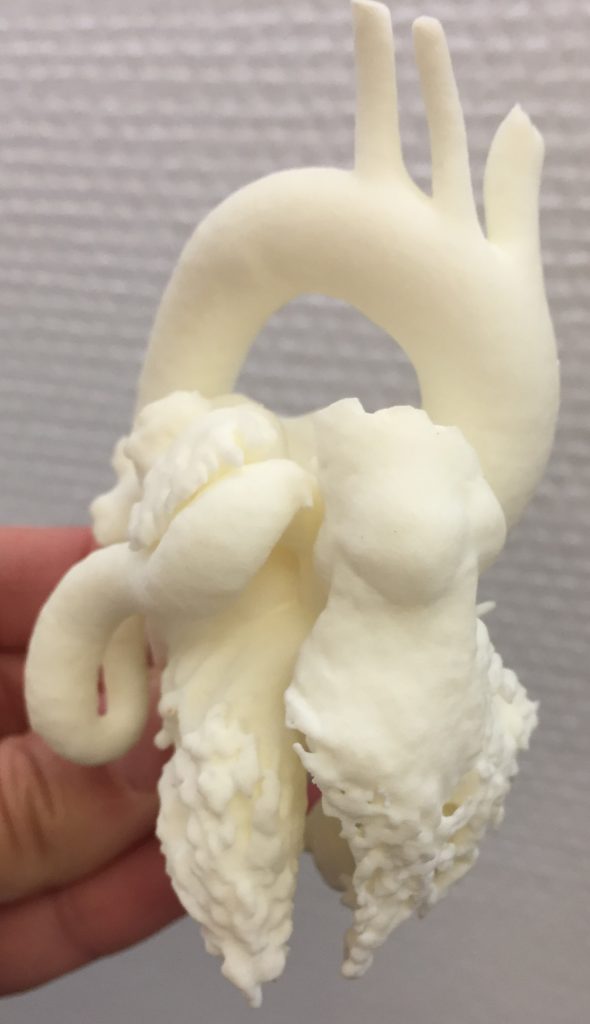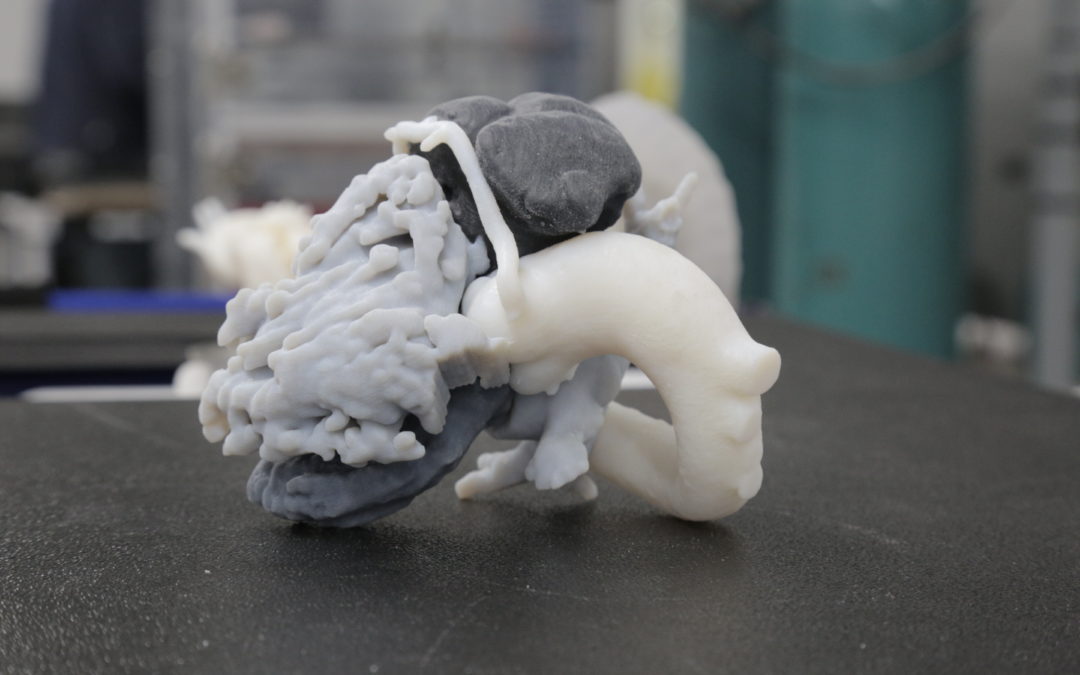GE Healthcare Life Sciences Opens $2M 3D Printing Center in Sweden
GE Healthcare Life Sciences has opened a new additive manufacturing (AM) facility in Umeå, Sweden that will be dedicated to integrating 3D-printed parts into the company’s production of biomanufacturing equipment. The site will be its second such center in Sweden, the first of which was opened in Uppsala, Sweden in 2018.
Together, the two centers will be used to for every stage of 3D printing, from prototyping to serial production. While the facility in Uppsala will engage in product design and validation activities, the Umeå perform serial production on those components.
The new site features an EOS 3D printer for polyamide parts, meant for serial production, as well as a powder mixing station and post-processing equipment. GE intends to fabricate parts for such bioprocess products as the newly released launched ÄKTA go chromatography system, as well as HiScale columns and Biacore SPR systems.

GE Healthcare Life Sciences engineers next to the 3D printer in Umeå. Image courtesy of GE Healthcare Life Sciences.
Olivier Loeillot, General Manager BioProcess at GE Healthcare Life Sciences, explained that the location of these centers was decided based on the fact that the company manufactures chromatography resins and bioprocess equipment in Sweden. As a result, GE will be able to deliver its technologies more quickly. As for the choice of 3D printing, Loeillot pointed out that 3D-printed parts are “smaller and more durable” than those made with traditional technology, which translates to “better quality, less waste, and simplified designs.”
Loeillot sees the new center as improving productivity to the company’s supply chain, which will benefit from increased agility offered by 3D printing. While we are still far from on-demand manufacturing closest to the point of use, GE is at least a step closer in co-locating its additive facilities within the same region, though it would have most likely launched any new site nearest to its main hub of activities for any given technology.
Other 3D printing activities engaged in by GE Healthcare include a partnership with Formlabs to 3D print patient-specific anatomical models, a process it wishes to streamline. The company is also working with pharmaceutical giant Amgen to test the viability of a 3D-printed chromatography column.
For those following the industry, there’s no need to mention that this is part of a larger strategy on the part of GE to adopt 3D printing wherever possible across its supply chain. After pioneering 3D printing for production of fuel nozzles, then turbine blades in its aerospace division, the conglomerate began 3D printing end parts for its Oil & Gas company in Japan. What could have seemed like an elaborate and expensive marketing campaign with the highly publicized fuel nozzle proved itself to be a commitment to innovation and market dominance across its supply chain.
This most recent facility for GE Healthcare Life Sciences demonstrates that we are just at the beginning of a new era in which AM will be increasingly adopted and really will take a chunk out of the $13 trillion manufacturing sector.
The post GE Healthcare Life Sciences Opens $2M 3D Printing Center in Sweden appeared first on 3DPrint.com | The Voice of 3D Printing / Additive Manufacturing.
GE Healthcare selects Formlabs as anatomical model 3D printing partner in hospitals
GE Explains how they Help Improve U.S. Veteran Healthcare
With over 1.3 million men and women on active duty and more than 450,000 of them stationed overseas, some of them deployed to conflict zones like Afghanistan, Iraq or Syria, and 20 million U.S. veterans, it’s no wonder the U.S. Department of Veterans Affairs (VA) is looking for ways to meet the medical, surgical and quality-of-life needs of America’s patriots. Some of their newest programs provide treatment for traumatic brain injuries, post-traumatic stress, suicide prevention and women veteran services, and in the past few years the VA has opened outpatient clinics, and established telemedicine, medical research and innovation to improve the lives of a diverse veteran population. One of their most promising ventures is a partnership with GE Healthcare to accelerate the use of 3D imaging in healthcare. As part of their research agreement, GE Healthcare provides the software and work stations, and the VA’s Puget Sound Health Care System provides feedback to the company on the use and results of the technology. In the past, the VA has used 3D software that wasn’t designed for medical use. Now, however, GE will provide software specifically designed for the medical field.
Together, VA and GE Healthcare will work to reduce the time it takes for radiologists to create 3D printed models  and prosthetics from hours to minutes, accelerate the identification of new imaging approaches, techniques, needed materials and post processing steps to enhance the health of the nation’s veterans. Through this partnership, GE will be able to help clinicians explore many different opportunities to use additive manufacturing across care areas, partnering with the VA’s innovation team, already engaged with printer manufacturers. As a company offering diagnostic imaging modalities, advanced visualization products, and in partnership with GE Additive metal printers and materials, GE Healthcare is uniquely positioned to support the VA’s investigations across the image-to-print workflow.
and prosthetics from hours to minutes, accelerate the identification of new imaging approaches, techniques, needed materials and post processing steps to enhance the health of the nation’s veterans. Through this partnership, GE will be able to help clinicians explore many different opportunities to use additive manufacturing across care areas, partnering with the VA’s innovation team, already engaged with printer manufacturers. As a company offering diagnostic imaging modalities, advanced visualization products, and in partnership with GE Additive metal printers and materials, GE Healthcare is uniquely positioned to support the VA’s investigations across the image-to-print workflow.
Building on its 3D printing network, VA Puget Sound and the Veterans Health Administration Innovators Network integrate GE Healthcare’s advanced visualization AW VolumeShare workstations with 3D printing software across its facilities in Seattle, San Francisco, Minneapolis, Cleveland and Salt Lake City. The AW Server is a medical software system that allows multiple users to remotely access AW applications from compatible computers on a network. The system allows networking, selection, processing and filming of multimodality DICOM images. VA has started to use AW VolumeShare 7 last november, a multi-modality image review, comparison, and processing workstation with simplicity and power at its core, featuring 64-bit technology that allows processing of up to 5K images in a single dataset.
3DPrint.com spoke to Colin Holmes, Senior Director, Additive & Visualization at GE Healthcare, about the advantages of working with GE’s Advanced Visualization Workstations.
The expert in application of high performance computing infrastructures to medical imaging said that “using the AW VolumeShare 7 workstations, VA radiologists specializing in cardiology, oncology, orthopaedics and general radiology can quickly produce and critique models from patient studies as part of their normal clinical tasks.” According to Holmes, “as these radiologists are full-time practitioners, efficiency improvements with AW will allow them to spend more time focused on patient care, guided by 3D printing outputs, and less time on the labor-intensive process of producing 3D models.”
VA Puget Sound radiologist and the VHA 3D Printing Advisory Committee chair, Beth Ripley, is quite eager to join forces with GE Healthcare, although the VA has been using 3D printing for a while, the new software should save time and make the technology more accessible. Last year she said that “for most radiologists, 3D images are limited to reconstructions on a computer screen, so by harnessing the power of 3D printing with a rich data set, we are able to pull images out of the screen and into our hands, allowing us to interact with the data in a deeper way to fuel innovative, personalized care based on the unique needs of each of our patients.”

A printed knee achieved using GE’s AW VolumeShare to accelerate the 3D printing process (Image: GE Healthcare)
“Typically imaging information is most fully understood by the radiologist, who combines the patient’s medical history with imaging results interpreted through the lens of years of radiology-specific training to recreate in his mind’s eye the full anatomy. Now, the critical information held within the medical imagery can be expressed physically, augmented with colour or scaled as needed. Physical models allow the surgeons, who need to combine the medical imagery with their view of the patient in the operating room, to better contextualize and share their understanding and decisions with the full team. While, patients can better understand a disease, express questions and make more informed decisions when they can interact with the models rather than having to deal with complex verbal descriptions best suited to those with advanced medical education,” described Holmes.

VA Puget Sound Health Care System radiologist Beth Ripley performs a quality check on a model of a kidney with a cancerous tumor
At this phase of their project, the VA teams working with AW VolumeShare 7 technology are using polymer printers that come from other companies to make models to explore their impact on surgical planning, resident teaching and training, and patient education. The VA operates one of the largest health care systems in the world and provides training for a majority of America’s medical, nursing and allied health professionals, roughly 60% of all medical residents obtain a portion of their training at VA hospitals. The VA health care system has grown from 54 hospitals in 1930 to 1,600 health care facilities today, including 144 VA Medical Centers and 1,232 outpatient sites of care. As the largest integrated health care system in the country, the VA not only cares for U.S. Veterans, but can advance change and positively disrupt the way America delivers health care.
The VA has been using 3D printing for some years now. From developing a 3D printed artificial lung that could help treat veterans affected by lung disease at VA Ann Arbor Health Care System, to reproducing near-exact replicas of body parts for Veterans using any of the five Stratasys 3D printers at VA hospitals in Seattle, Albuquerque, San Antonio, Boston and Orlando. Stratasys even went a step further and introduced AM job training and certification initiatives for the military veterans at San Diego.

A printed baby heart achieved using GE’s AW VolumeShare to accelerate the 3D printing process (Image: GE Healthcare)
GE Healthcare, made $17 billion in revenues last year and is one of the world’s top three med-tech companies by size. It has the world’s largest installed base in imaging, mobile diagnostics and monitoring, with over 4 million systems in use worldwide and a leading portfolio of contrast media and nuclear medicine agents that enhance the acuity of diagnostic imaging systems, these pharmaceutical diagnostics are used in three patients every second around the world.
“We have been on our Additive Journey for nearly six years, and a lot of our early investments into additive technology and people were focused on printing polymer structures which fit well in the medical model printing space. Over time we have been partnering with our Imaging teams to further accelerate the process to go from a medical image scan to a printed medical model,” described Holmes. Additive manufacturing is an evolving tool across the GE spectrum, from providing optimizations and innovation for parts in their leading imaging systems to new ways to explore, learn and share understanding of the data they generate.
So, how do we expect hospitals and medical research facilities -like VA Puget- will advance patient healthcare into the next decade? According to Holmes, leading research and teaching hospitals are almost all engaged in early work to incorporate additive manufacturing into their programs, from basic science to enhanced education, combined with AR and VR, to new diagnostic and therapeutic tools.
“As healthcare begins to benefit from the fourth wave of industrialization, these new combined digital and manufacturing approaches are tremendously exciting as enablers and accelerators of much broader access to current healthcare standards worldwide,” he revealed.
Considering this is an investigation in early stages and there are still no quantified outcomes, only time will tell the degree to which this will improve the lives of over 110,000 veterans across the nine facilities of VA Puget Sound in the Pacific Northwest. However, it is safe to say that 3D printing technology is already improving patient experience, reducing treatment time and decreasing the cost of care for the millions of veterans in the United States, as well as patients worldwide. Most doctors are starting to see the benefits of moving from flat layered images to the replicated organic structures they will encounter in the operating room, and patients can understand a 3D print much better than a CT or an MRI scan. Right now, only about 3% of hospitals and research institutions have 3D printing capabilities on site, but at the rate it has advanced in the last couple of years we can expect a future widening use of the technology.

